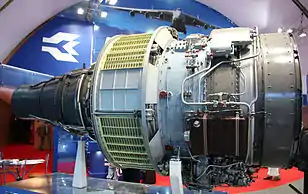Progress D-436
The Progress D-436 is a three-shaft high by-pass turbofan engine developed by the Ukrainian company Ivchenko-Progress, and manufactured by Motor Sich in Ukraine.[1] It was initially developed to meet the requirements for late versions of the Yakovlev Yak-42 and the Antonov An-72 in the 1980s. The engine first ran in 1985 and was subsequently certified in 1987.[2] Several variants have been developed and are currently in service with a variety of aircraft.
| D-436 | |
|---|---|
 | |
| D-436-148 turbofan engine for An-148 | |
| Type | Turbofan |
| National origin | Soviet Union/Ukraine |
| Manufacturer | Ivchenko-Progress, UMPO and NPC Saljut |
| First run | 1985 |
| Major applications | Antonov An-148 Tupolev Tu-334 Beriev Be-200 |
| Developed from | Lotarev D-36 |
Design and development
The D-436 engine was developed as a follow on to the Lotarev D-36. The engine took several of its design features from that engine and another Progress engine, the Progress D-18. The D-436 incorporated an updated, higher RPM fan, a lower emissions combustor, and new compressor sections. Several variants of the engine incorporate a FADEC.
The Motor-Sich plant in Zaporozhie, where the assembly line for D-436 engines was located,[3] was destroyed by Russian forces in late May 2022 following the 2022 Russian invasion of Ukraine.[4]
Variants
.jpg.webp)
- D-436K
- The "K" variant was the initial model of the engine. It had a bypass ratio of 6.2 and a pressure ratio of 21.0. Proposed for use in the defunct Antonov An-71.[5]
- D-436M
- The "M" variant was proposed for use on the Yak-42M.[6]
- D-436T1
- The "T1" variant is used on the Tu-334 and has been offered for use on the in-development Tu-414.[7] See detailed specifications below. The variant was also proposed for use on the now-defunct An-174.
- D-436T1-134
- The "T1-134" variant was proposed as a replacement for the engines on the Tu-134.
- D-436T2
- The "T2" variant is uprated to 80 kN (18,000 lbf) of thrust and is used on the Tu-334-100D and the Tu-334-200D.[8]
- D-436TP
- The "TP" variant is a specific "maritime" corrosion-resistant version developed for use in the Be-200 amphibious aircraft. This variant produces 7,500 kgf (16,534 lbf) each.
- D-436T3
- The "T3" variant added a booster section behind the new wide-chord fan and had a maximum thrust around 93 kN (21,000 lbf).[9] The T3 variant was also considered for the Il-214, but the aircraft's thrust requirements exceeded the max engine thrust of 98 kN (22,000 lbf).[10]
- D-436-148
- The "-148" variant was developed specifically for the An-148.[11] This version is derated to 67 kN (15,000 lbf) of thrust for longer engine life.[12]
- D-436TX
- The "TX" variant uses the same core at the "T3", but includes an updated turbine and a geared fan. It is in the 117–135 kN (26,000–30,000 lbf) class.[9]
Derivatives
- AI-436T12
- This derivative engine was designed for use on the Irkut/Ilyushin MC-21. It was projected to produce 117 kN (26,000 lbf) of thrust.[13] Irkut has since replaced the AI-436T12 with the 137.89 kN (31,000 lbf) Aviadvigatel PD-14.[14][15]
Specifications (D-436-T1)
Data from Elodie Roux,[16] page 159
General characteristics
- Type: Three-spool high-bypass turbofan
- Length: 3.03 m (9 ft 11 in)
- Diameter: 1.373 m (4 ft 6.1 in)
- Dry weight: 1,450 kg (3,200 lb)
Components
- Compressor: Axial flow, 1-stage fan, 6-stage IP, 7-stage HP
- Turbine: 1-stage HP, 1-stage IP, 3-stage LP
Performance
- Maximum thrust: Takeoff: 7,650 kgf (16,865 lbf; 75.02 kN); Cruise: 1,500 kgf (3,307 lbf; 14.71 kN) at Mach 0.75 speed, 11,000 m (36,000 ft) altitude
- Overall pressure ratio: 25.2
- Bypass ratio: 4.95
- Air mass flow: 606.3 lb/s (275.0 kg/s)
- Turbine inlet temperature: 1,550 K (2,790 °R; 1,280 °C; 2,330 °F)
- Specific fuel consumption: Takeoff: 10.6 g/(kN⋅s) (0.37 lb/(lbf⋅h)); Cruise: 17.3 g/(kN⋅s) (0.61 lb/(lbf⋅h))
See also
Related development
Comparable engines
- CFM International CFM56
- General Electric CF34
- IAE V2500
- PowerJet SaM146
- Pratt & Whitney PW6000
- Rolls-Royce BR700
Related lists
References
Notes
- "Ukraine bans deliveries of D-436 civil aircraft engines to Russia". Tass, February 19, 2018. Retrieved July 29, 2022.
- "Ivchenko-Progress D-436 (Ukraine), Aero-engines - Turbofan". 31 March 2009. Archived from the original on 14 August 2009. Retrieved 12 August 2009.
{{cite encyclopedia}}:|work=ignored (help); Missing or empty|title=(help) - "Be-200 Indigenous Engine Delays Drive Be-12 Life Extension". AINonline, April 20, 2019. Retrieved September 19, 2022.
- "Russia Says It Destroyed Ukrainian Military Engine Plant". Newsweek, May 26, 2022. Retrieved September 19, 2022.
- Fricker, John (4 December 1995). "Russian AWACS programs face funding problems". Aviation Week and Space Technology. Vol. 143, no. 23. pp. 89–90, 92. ISSN 0005-2175.
- "ZMKB Progress". Flight International. 8 October 1996. ISSN 0015-3710.
- "Tu-324/414 (2003)". Flight International. 28 October – 3 November 2003. p. 57. ISSN 0015-3710.
- "Tupolev (1999)". Flight International. 1–7 September 1999. p. 73. ISSN 0015-3710.
- "ZMKB Progress (2004)". Flight International. 23–29 November 2004. p. 61. ISSN 0015-3710.
- "India needs more power for Il-214". Flight International. 29 April 2002. ISSN 0015-3710.
- "An-148 final assembly gets under way at Kiev". Flight International. 15 March 2004. ISSN 0015-3710.
- "An-148 design tweaked as date for first flight approaches". Paris Air Show Report 2003. Flight International. 23 June 2003. ISSN 0015-3710.
- ENGINES (2008). DEFENSE and SECURITY (Russia). No. 100, September 10, 2008
- "Irkut Removes Pratt & Whitney Engine Option From The MC-21". SimpleFlying, April 25, 2022. Retrieved June 10, 2023.
- "MC-21 test aircraft flies with PD-14 engines after swap from PW-1400Gs". FlightGlobal, October 7, 2022. Retrieved June 10, 2023.
- Élodie Roux (2007). Turbofan and turbojet engines: Database handbook. pp. 159–160. ISBN 9782952938013. OCLC 804131087.